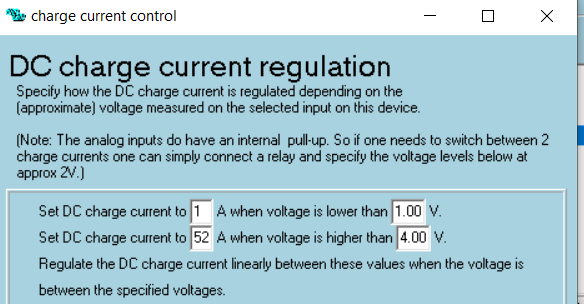I’ve just installed a system comprising of a Multiplus II 48|3000|35, 2-off MPPT 150|70, Lynx Distributor & Smart BMS, Cerbo GX & Display, and a bank of Smart Lithium batteries. It is installed on a boat that has mains shoreline connection.
I’d like to prioritise the charging such that the batteries are only charged from the shoreline input when necessary (i.e. prioritising use of solar generation) but I do not want to feed back to the grid.
I would also like to implement an easy way for the user to manually demand a full charge from the shoreline when required - preferably via the touch display.
It seems that the Hub-1 Self-Consumption assistant doesn’t quite offer what I’m looking for - the nearest policy seems to be ”Disconnect from the mains when possible” but that policy allows feedback to grid, and that is not desirable in this application.
Any help greatly appreciated.
- Home
- Anonymous
- Sign in
- Create
- Spaces
- Grafana
- Node-Red
- Unsupported topics
- Questions & Answers
- Modifications
- Communauté francophone
- Deutschsprachiger Bereich
- Preguntas en Español
- Explore
- Topics
- Questions
- Ideas
- Articles
- Badges
question
Self-Consumption Without Grid Feedback
ESS is not for use in mobile applications, ie. Anything with a detachable power cord.
Yes, I've read that ESS is not to be used for mobile systems, which is why I was hoping to achieve this using the Hub-1 Self-Consumption assistant.
Grid feed, in this application, would be dangerous. That's why I want to disable it, and have confidence that it is definitely disabled.
The supply is periodically turned off for site maintenance - allowing grid feed would mean that parts of the site infrastructure would be kept live by this system despite being isolated from the grid. Aside from this, the shoreline input socket which the shoreline power cable plugs into has exposed pins, so I don't want to present a voltage on pins that could be touched.Yes - my understanding is that when grid feed is disabled in ESS, the voltage at AC IN in is held at a lower voltage than the grid to prevent grid feed, but an AC voltage is still present at that terminal, which would make it dangerous for my application.
Good to understand, but unfortunately eliminates ESS as a possible solution. I’m surprised that there doesn’t seem to be a solution. It seems like quite a basic requirement to disable the charge function of the multiplus above a certain battery SOC and enable it below a certain threshold, but I can’t seem to find a way of doing this without presenting a voltage at AC IN.
Not sure what you mean by "presenting a voltage at AC IN", but you can do it without a V with this Assistant..

Read the 'Note'. You'd need a wire pair from somewhere, like a switch, a Cerbo relay, or even a Multiplus output relay. You could build everything you've mentioned with Assistants at the heart.
Also, to give solar priority when Shore is running at the same time, set the Shore Charge V just slightly lower than the solar's. Think about the different charge states when doing this. DVCC also good to set up so that all kit sees the same V source.
Forget ESS, it's just one Assistant. There's plenty others, also Cerbo Gen Start to play with too.
There is the software switch in the GX - inverter only _ charger _off.
The same thing can be achieved with a DMC which also allows a change to the input current limit.
You could do an AC ignore system that can be overridden on demand.
The generator stop start function on the GX to "switch on grid" as well with switchgear. There is a way to integrate it for working the primary relay as well. Takes a bit more set up.
This might be helpful: https://youtu.be/sbLREfC7ocU
So as said in previous comment, Virtual Switch should work.
I have the same setup.
Using Dedicated AC-Ignore virtual switch.
The system switches to grid when the battery is under 25.00V
The system switch back off grid when the battery is over 26.00V
The inverter remains in the "ON" state.
The charger is enabled, but set to 25.00V absorb and float.
To enable a battery charge I just need to adjust that charge voltage up to 28.80V
I have not done that final step, or not made it "push button" easy, yet.
There may be some mileage in using the "Manual Equalisation" function with it's voltage set to the battery full voltage such it only engages on demand. I do similar with the MPPT as they tend to make a mess at top of charge if there are balance issues. So they top out at 28.00V and only when I enable the manual equalisation does it push up to 28.80V on a single MPPT controller out of 3.
I may be mistaken, but ESS requires network operator "grid code" entry, which usually requires local regulations and thus not likely available on "shore power" links.
By not entering the grid code and remaining "plug socket" connected that lowers the requirements.
question details
125 People are following this question.
